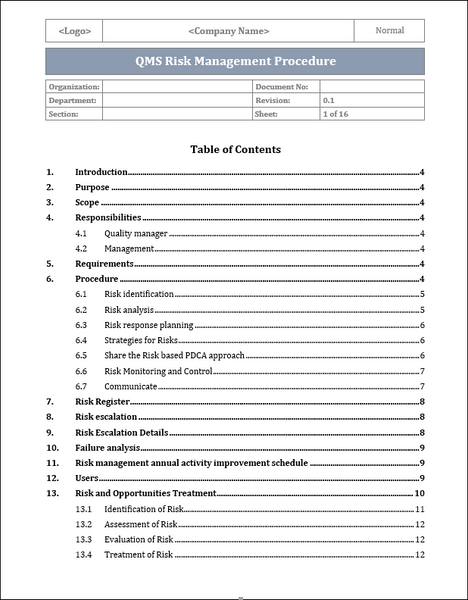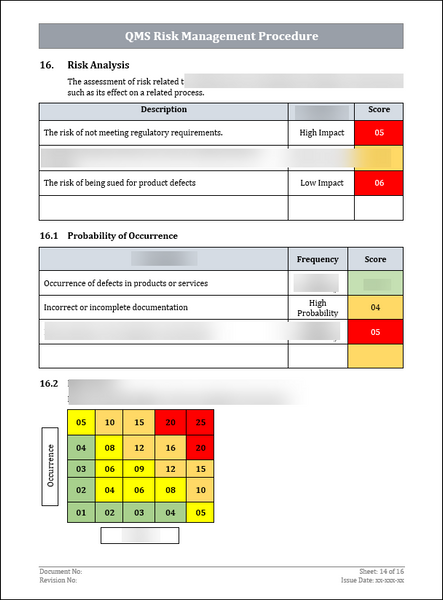ISO 9001 Risk Management Procedure
The Risk Management Procedure Template for ISO 9001 is a comprehensive document that guides organizations in effectively managing risks in their quality management system. It aligns with ISO 9001 requirements to enhance customer satisfaction.
The template includes risk identification, assessment, mitigation, monitoring, and documentation. By using this template, organizations can establish a structured and effective risk management process that improves their quality management system's performance and resilience.

Understanding the importance of risk management procedure template in ISO 9001
The risk management procedure template is crucial in ISO 9001 because it helps organizations identify, assess, and mitigate risks that could impact the quality of their products or services. Here are some reasons why it is important:
- Compliance with ISO 9001: ISO 9001 requires organizations to establish a risk-based approach to quality management. A well-defined risk management procedure template ensures that organizations meet this requirement and can effectively handle risks related to their processes, products, or services.
- Identification of potential risks: The procedure template helps organizations systematically identify potential risks that may affect their ability to meet customer requirements. This can include risks related to supply chain, production, design, or any other area of the organization's operations.
- Assessment of risks: The template provides a structured framework for assessing the identified risks. It allows organizations to determine the likelihood and severity of each risk and prioritize them based on their impact on quality.
- Mitigation and prevention: Once risks are identified and assessed, the template guides organizations in developing appropriate mitigation strategies. It helps organizations implement preventive measures to reduce the likelihood or impact of risks, minimizing the chances of quality issues or failures.
- Continuous improvement: The risk management procedure template enables organizations to continuously monitor and evaluate the effectiveness of their risk management processes. It provides a basis for reviewing and improving the procedures as necessary to ensure that risks are appropriately managed and mitigated.
- Demonstrating commitment to quality: By having a well-defined risk management procedure template, organizations demonstrate their commitment to quality management. It shows that they have a structured approach to identify and manage risks, ensuring consistent delivery of high-quality products or services to customers.
Overall, the risk management procedure template in ISO 9001 plays a vital role in helping organizations proactively manage risks, prevent quality issues, and achieve their quality objectives.

Key components of a risk management procedure in ISO 9001
The key components of a risk management procedure in ISO 9001 include:
- Risk identification: This involves identifying potential risks that may impact the organization's ability to achieve its objectives. Risks can be internal or external, and can stem from various sources such as operational, financial, legal, or environmental factors.
- Risk assessment: This step involves evaluating the identified risks based on their likelihood of occurrence and their potential impact on the organization. Risks can be categorized based on their severity and probability, allowing the organization to prioritize them.
- Risk analysis: This involves analyzing the identified risks in more detail to understand their root causes and potential consequences. This analysis helps the organization in understanding the nature of the risks and determining appropriate risk mitigation measures.
- Risk mitigation: This step involves developing and implementing risk mitigation measures to reduce the likelihood or impact of identified risks. These measures can include process improvements, corrective actions, preventive actions, or implementing controls to minimize the risk.
- Risk monitoring and control: This involves monitoring the effectiveness of the implemented risk mitigation measures and evaluating their ongoing performance. Regular review and assessment of risks allow the organization to adapt and adjust its risk management strategies as needed.
- Risk communication: This involves ensuring effective communication of risks and risk management activities within the organization. This includes informing key stakeholders, employees, and relevant parties of identified risks, mitigation measures, and any changes in the risk management process.
- Risk documentation: Maintaining a documented record of the risk management activities is essential to demonstrate compliance with ISO 9001. This documentation should include risk registers, risk assessments, risk mitigation plans, and any other relevant records.
- Continuous improvement: Organizations should continuously review and improve their risk management processes to ensure their effectiveness. Regularly evaluating the effectiveness of risk management measures, learning from past experiences, and implementing improvements are fundamental to achieving better risk management outcomes.
Benefits Risk Management Procedure Template for ISO 9001
Benefits of Risk Management Procedure Template for ISO 9001:
- Consistency: By implementing a risk management procedure template, organizations can ensure consistency in identifying, assessing, and managing risks across different processes and departments. This helps in creating a standardized approach to risk management.
- Compliance: ISO 9001 requires organizations to have a systematic approach to risk management. By using a risk management procedure template, organizations can demonstrate compliance with this requirement, which is essential for maintaining ISO 9001 certification.
- Improved Decision Making: A well-defined risk management procedure provides a structured framework for decision making. It helps organizations in making informed decisions by considering the potential risks associated with different options. This can lead to better decision-making outcomes and prevent unexpected negative consequence
- Proactive Approach: A risk management procedure template encourages organizations to take a proactive approach towards risk identification and mitigation. By identifying and assessing potential risks in advance, organizations can take preventive measures to minimize the impact of risks and avoid costly mistakes or failures.
- Increased Efficiency: Implementing a risk management template can streamline the risk management process, making it more efficient. It provides a clear roadmap for risk assessment, treatment, and monitoring, ensuring that all necessary steps are followed consistently. This can save time and resources in dealing with potential risks.
- Stakeholder Confidence: Using a risk management procedure template demonstrates an organization's commitment to managing risks effectively. This can enhance stakeholder confidence, including customers, investors, and regulatory bodies, who can trust the organization's ability to identify and manage risks that may impact their interests.
- Continuous Improvement: A risk management procedure template supports the principle of continuous improvement. By reviewing and evaluating the effectiveness of risk control measures, organizations can identify areas for improvement and implement corrective actions. This helps in enhancing overall risk management capability and reducing the likelihood of future incidents.
- Business Resilience: Implementing a risk management procedure template ensures that organizations are better prepared to deal with unexpected events or disruptions. By identifying and assessing potential risks, organizations can develop robust contingency plans and response strategies. This increases the resilience of the business and enables a swift recovery from adverse events.
- Enhanced Reputation: Effective risk management practices can contribute to building a positive reputation for an organization. By demonstrating a proactive approach to risk management, organizations can enhance their image as reliable and trustworthy. This can attract customers and stakeholders who prioritize working with organizations that prioritize risk management.
- Integration with Other Management Systems: The risk management procedure template can be integrated with other management systems, such as quality management, environmental management, or health and safety management. This integration helps in aligning risk management practices across different functions and enables a holistic approach to managing risks.
Conclusion
Implementing ISO 9001 streamlines risk management by providing a systematic approach to identifying and controlling risks. It encourages proactive, rather than reactive, risk management and includes clear objectives and processes for risk identification and treatment.
ISO 9001 also emphasizes the importance of continual monitoring and review of risks. By aligning risk management practices with ISO 9001, organizations can improve operational efficiency, meet customer requirements, and demonstrate a commitment to quality and risk management. Overall, ISO 9001 enhances risk management practices and organizational performance.



